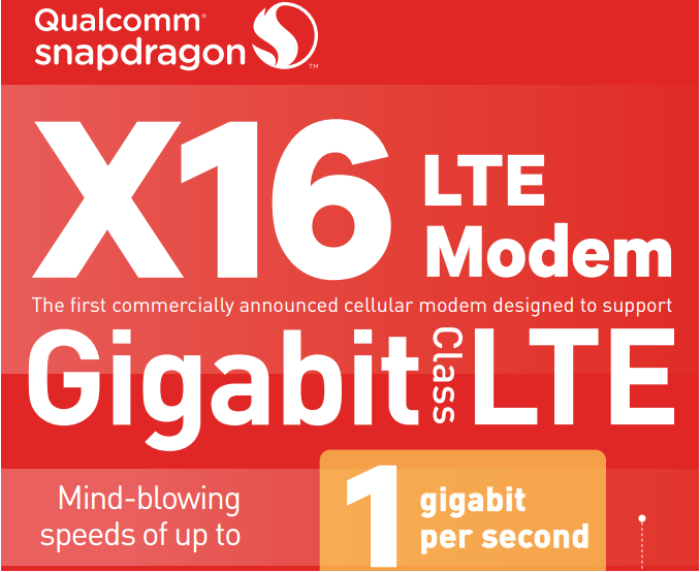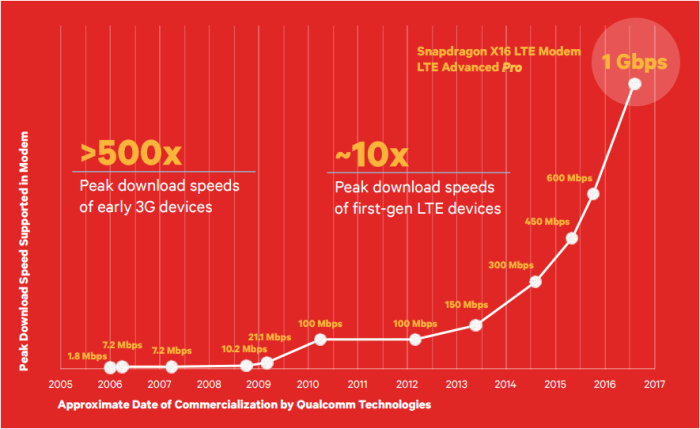
Qualcomm Technologies has introduced its Snapdragon X16 LTE modem, built on a 14nm FinFET process — and the Qualcomm RF Transceiver, WTR5975.
The chipset maker claims that Snapdragon X16 LTE modem is the first commercially announced Gigabit Class LTE chipset designed to deliver fiber-like LTE Category 16 download speeds of up to 1 Gbps, supporting up to 4×20 MHz downlink Carrier Aggregation (CA) across FDD and TDD spectrum with 256-QAM, and 2×20 MHz uplink carrier aggregation plus 64-QAM for uplink speeds up to 150 Mbps.
Snapdragon X16 LTE modem supports Licensed Assisted Access (LAA), the global standard for LTE in unlicensed spectrum, becoming the mobile industry’s first LTE Advanced Pro modem.

Qualcomm Snapdragon X16 LTE modem is designed to reach Gigabit Class LTE speeds using the same amount of spectrum as Category 9 LTE devices. By using carrier aggregation and 4×4 MIMO, the Snapdragon X16 LTE modem can receive 10 unique streams of data using only three 20 MHz carriers.
Its support for 256-QAM boosts the peak throughput of each stream from ~75 Mbps to ~100 Mbps, with additional gains possible with modem data compression.
The new LTE modem and transceiver support Snapdragon All Mode, including major technologies such as LTE FDD, LTE TDD, WCDMA, TD-SCDMA, EV-DO, CDMA 1x, and GSM/EDGE, frequency bands, Carrier Aggregation band combinations, LTE dual SIM, LTE Broadcast, HD and Ultra HD Voice over LTE (VoLTE) with single radio voice call continuity to 3G and 2G.
Snapdragon 625, 435 and 425 processors
Chipset maker Qualcomm Technologies has launched three new Snapdragon 625, 435 and 425 processors.
Support for LTE with carrier aggregation, Snapdragon All Mode, support for 802.11ac with MU-MIMO, dual camera image signal processors (ISPs), Qualcomm TruSignal technology for improved call reliability, Qualcomm Hexagon DSP for power efficient audio with sensor hub and Qualcomm Quick Charge are some of the features of the latest Snapdragon processors.
Snapdragon 435 and 425 are pin compatible with each other and with Snapdragon 430. Snapdragon 635, 435 and 425 are software compatible.
Snapdragon 625
Snapdragon 625 processors use 14 nm FinFET technology, yielding up to a 35 percent reduction in power consumption compared to the previous generation. It incorporates an octa-core ARM Cortex-A53 CPU and includes an integrated X9 LTE modem, supporting 4G+.
With peak upload speeds of 150 Mbps – 3x as fast as traditional LTE devices – the X9 LTE modem supports faster sharing of the superior videos and photos made possible by the Snapdragon 625 processor’s camera capabilities. It supports dual cameras, 24 megapixel photos, and up to 13 megapixel selfies. 625 supports PC-class graphics with Qualcomm Adreno 506 graphics processing unit (GPU), which is designed to support the Vulkan API.
Snapdragon 435
The Snapdragon 435 integrates an octa-core ARM Cortex-A53 CPU and X8 LTE modem, supporting 4G+, with 2×20 MHz carrier aggregation for faster downlink (up to 300 Mbps) and uplink (up to 100 Mbps) LTE speeds. It supports 1080p user interface with 60 frames per-second, dual ISPs enabling 21 megapixel photos and advanced features like hybrid autofocus and is a leader in image quality in this tier. It also includes the Adreno 505 GPU for PC-class graphics.
Snapdragon 425
The Snapdragon 425 ups the entry point for the 400 tier and provides a solid upgrade path for the Snapdragon 410 and 412 customers with a 64-bit, quad-core ARM Cortex-A53 CPU, an Adreno 308 GPU, and HD display at 60 frames per-second.
The 425 also includes an integrated X6 LTE modem with 2×10 MHz carrier aggregation and upload speeds up to 75 Mbps with 64-QAM to allow for cost-effective smartphones designed with high-speed LTE connectivity for China and emerging regions.
Meanwhile, Qualcomm Technologies introduced Qualcomm Snapdragon Wear, a new platform for next generation wearable devices, and the Snapdragon Wear 2100 system-on-chip (SoC).





